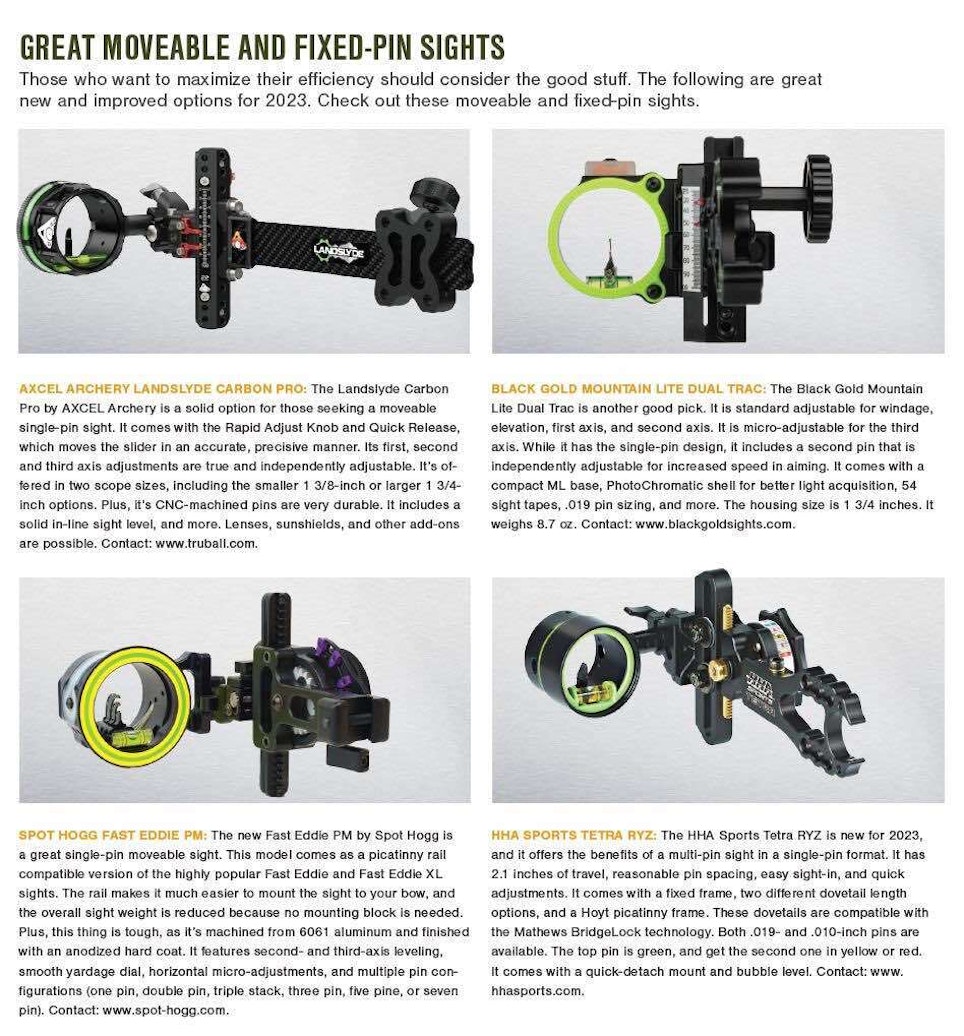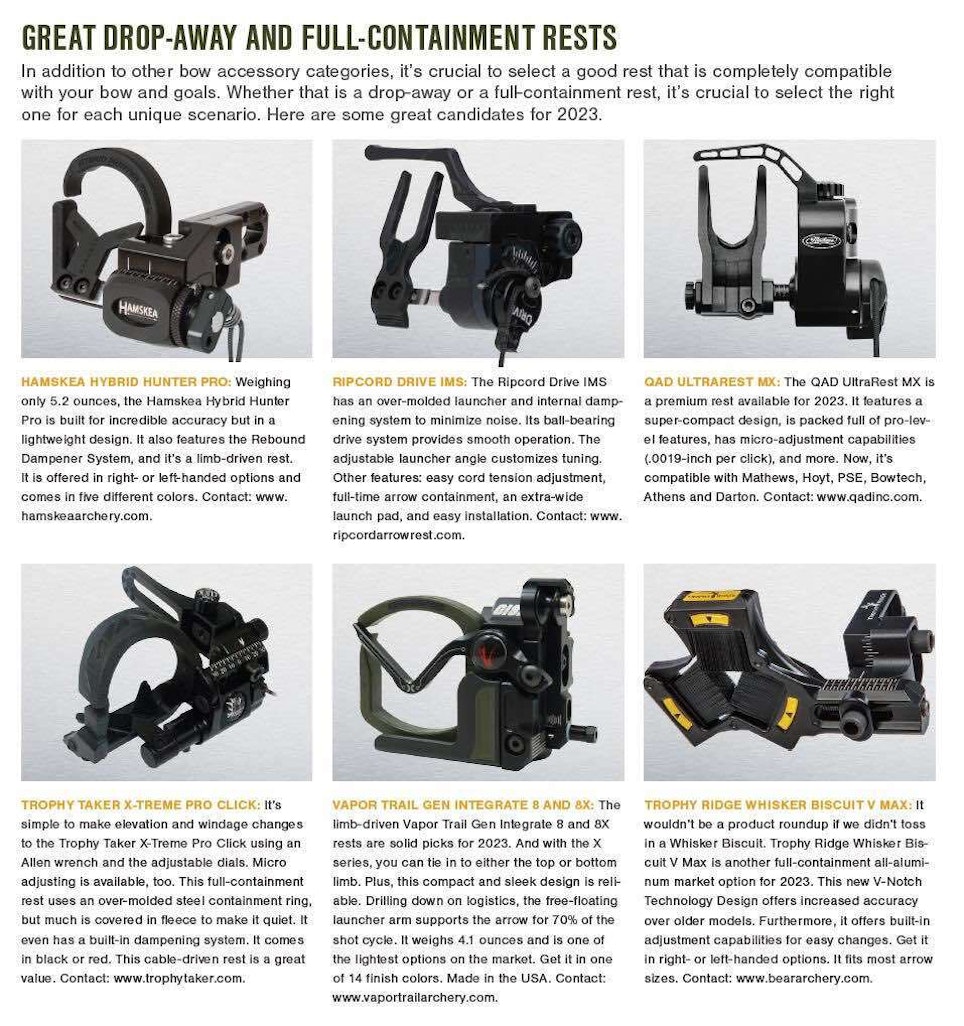Never have bowhunters had access to such effective and intuitive compound archery technology. Modern setups are cram-packed with the newest technologies. Bows are shooting more accurately than ever before. A lot of that is due to topping off outfits with great bowsights and arrow rests.
The slate of latest offerings is no exception. Despite the advancements, it’s crucial to sort through the crop of new and improved products to determine what’s best. Of course, the importance of choosing a dependable bowsight, and the importance of choosing a dependable arrow rest, are near the top of that hierarchy list. Here is a breakdown on need-to-know sight and rest info, and some great options for your bow in 2023.
Fixed-Pin Sight Designs
Between fixed-pin and moveable sights, the former have been around longer. Fixed pins offer numerous advantages. These sights are certainly more automated on the fly, as there is not adjusting of the pins. So, it’s easier to stay on moving targets. It also requires less movement because you don’t have to reach up and adjust the sight. And there are fewer mechanical parts to malfunction.
It doesn’t come without negatives, though. These take more time to initially set up. Oftentimes, these have a more cluttered sight picture. The archer must remember to use the correct yardage pin. And there isn’t always an exact yardage marker, so shooters must accommodate pin gaps.
Moveable (Slider) Sight Designs
Newer to the scene than its fixed-pin counterpart, moveable slider bowsights are quickly becoming increasingly popular. Generally, these are single-pin designs, but some have second or third pins that are stagnant and don’t move.
Of course, moveable sights have plenty of advantages. Moveable-pin sights offer a more open (less cluttered) sight picture. These also provide exact pin yardage, so no need to aim high, low or split the pin distances. You also don’t have to think about which pin to use.
It comes with negatives, though. The archer must set distances with each shot, which requires more movement. If an animal moves, the hunter must know the holdover, or let back down to readjust, especially if the animal moves very far. The extra time these steps take can result in missed opportunities.
Universal Bowsight Considerations
There are universal points and considerations to remember for all sights, though. Due to the increase in speed of bows, distance between pins doesn’t matter as much now as it did in the past. This means shots are more forgiving if the yardage is off slightly, which benefits all sights.
Sight pins are generally available in three sizes: .010, .019 or .029 inches. The largest size (.029-inch diameter) is easiest to see during low-light conditions, but it’s also less accurate due to covering more of the target at greater distances. Pins measuring .019 offer increased accuracy and are still decent in low light, which is likely the reason they are the most popular option for bowhunters.
Pin guard designs matter, too. Most of these are round now, especially given that these are superior when attempting to find the same anchor point each time. Round guards help with this by aligning these with the peep sight to find the same anchor with each draw. Similarly, some sights have bubble levels, which helps identify if the shooter is canting the bow. Over time, it retrains the shooter not to cant the bow, ultimately boosting performance.
Sights also offer varying degrees of adjustability. Group adjustments move all pins, and micro adjustments move individual ones. Different sights have different abilities. The same holds true for lighted pins, which aid in low-light conditions.
Arrow Rest Designs
Open, static rests were once the norm. However, rarely are they used by modern bowhunters. Much better options are available now, and except for competitive target shooting, archers have largely relegated the open static rest to history.
Drop-away rests are perhaps the most popular now. These come in different varieties. Cable-driven rests use a cord that, when the bow is drawn, pulls on the cord that’s attached to the cable, effectively raising the rest into position. In contrast, when the arrow is released, the rest drops down and away from the arrow.
Limb-driven rests also use a cord but connect to a top or bottom limb. When not at full draw, the cord keeps the rest in the downward position. Then, once coming to full draw, the cord goes slack, and the rest rises upward. Once the arrow is released, the string tightens, and the rest falls again.
While limb-driven rests are usually slightly more accurate, the cable-driven rest has a shorter cord to get caught up in vegetation and other things. Shooters using limb-driven rests don’t have to worry about potential timing or bounce back issues. Typically, limb-driven rests are the most expensive of options.
The third option is an inertia-driven rest. This too uses a cord attachment, but it can remain in the upright position whether the bow is drawn or not drawn. Furthermore, it can be cocked upright with a thumb tab on the underside, which most shooters use. Then, once the bow is drawn and released, inertia drives the rest downward and away from the arrow.
Drop-away rests offer several advantages. These provide less friction with arrows. These also provide better accuracy and velocities. In fact, when compared to a full-containment rest, such as a Whisker Biscuit, as much as 5-6 fps can separate the two categories. Plus, due to the preference for arrow containment, many drop-away rests have side and over-the-top guards now.
These don’t come without negatives, though. Arrows can still fall off drop-away models, even those that offer forms of containment. There is also an increased chance of mechanical failure. And of course, these tend to have higher price tags.
Full-containment rests are also available. These have a few advantages, including minimal risk of arrows falling off the rest. These are also more rugged in design, meaning there are fewer mechanical parts to fail.
These come with negatives, too. The friction between the arrow and rest diminishes speed and reduces accuracy. Plus, movement of the bow arm between the trigger pull and complete departure of the arrow can impact the shot even more. Even if you don’t move the bow arm, an arrow flexes as it leaves the bow. Some believe the contact made from full-capture static rests impede the goal for utmost accuracy.
There are many things to consider when choosing a bowsight or arrow rest. Both categories offer subcategories of options, and finding the right option is a crucial decision. Understanding the ins and outs of each type, and the product that fit a hunter best, is a significant part of archery success.











